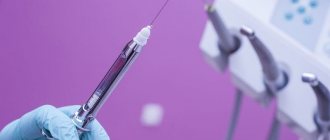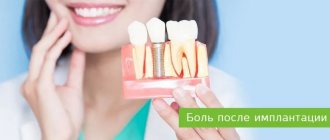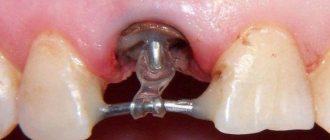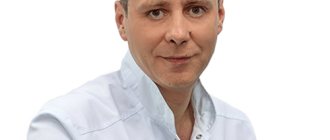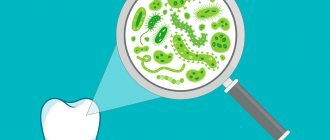When is suturing necessary in dentistry?
Surgical intervention is performed if:
- cystectomy - removal of a medium to large cyst that extends over several dental units. Resection of the apex of the previously sealed roots occurs;
- cystomy - partial removal of the cyst in order to reduce the pressure inside the formation and its gradual flattening;
- eliminating certain inflammatory processes - opening abscesses, treating osteomyelitis, periodontitis;
- gingivectomy - excision of overgrown gum tissue;
- gingivoplasty - tissue transplants to improve the aesthetics of the gums;
- removal of dental units - resection of a wisdom tooth is especially often accompanied by suturing;
- preparation for prosthetics - alveoloplasty, sinus lift, bone block transplantation.
A deep incision in the soft tissues of the oral cavity always requires sutures.
Types of suture material
Material for suturing is divided into two large groups - absorbable and non-absorbable.
Absorbable suture materials include:
- catgut is a thread obtained from purified connective tissue; when left in the oral cavity for a long time, the possibility of an inflammatory process arises due to rejection of the material;
- vicryl - synthetic threads containing polyglycomic acid, polyclatin, do not provoke the development of inflammatory processes, which makes it possible to use them where there is a high risk of postoperative complications.
Non-absorbable suture material:
- monofilament - a synthetic thread with a rigid structure that can injure the mucous membrane;
- silk is an elastic, durable material, but requires timely removal of sutures (after 10 days it causes inflammation of the soft tissues);
- polyster is a durable woven thread that requires special care when fixing; in order to make it more smooth, it is often coated with silicone.
Sutures in implantology for beginners
Since dental implantation damages soft tissues, it is important for a good implantologist to know all the intricacies of suturing after implant installation.
As you know, in dentistry several types of materials are used for suturing after surgery. They are divided into absorbable and non-absorbable. All materials have different origins and some are not suitable for sutures after implantation. Why? Find out further in the article!
Absorbable suture materials include catgut, dexon and vicryl.
Catgut is considered a classic natural suture material because it has been used in dentistry for over 150 years. As a rule, sutures made of this material remain in the oral cavity for up to two weeks. To properly tie a catgut suture, you will need both surgical and regular knots. This material is resorbed through phagocytosis and the action of enzymes.
When using this material, it is worth remembering that it can cause inflammation of the soft tissues, since it consists of foreign proteins. For this reason, catgut should not be used during dental implantation and tissue transplantation, because the inflammatory reaction can negatively affect the result of the operation.
Synthetic absorbable materials include Dexon and Vicryl. These materials have different origins: dexon is made from polyglycomic acid, and polylactin is used to make vicryl. Despite the fact that both materials are much easier to tie than kergut, when working with them you cannot do without surgical sutures.
The resorption of these materials is facilitated by hydrolysis, which is completed in about a month. Both materials are suitable for dental implantation because they do not cause inflammatory reactions. It is important to note that sutures must be removed no later than 10 days after surgery.
Non-absorbable suture materials include silk, braided polyester and monofilament sutures.
A frequently used non-absorbable suture material is silk. This material is made from silkworm proteins. This is a very convenient material to use for both the doctor and the patient. In addition, knots made of silk material are famous for their strength. Such threads are removed from the wound on days 5–7 of rehabilitation. The only disadvantage is that this material causes inflammation of the mucous membrane. Because of this, it is practically not used for alloying vessels, fixing flaps and bone grafts.
Woven polyester threads have the same positive properties as silk, but do not cause inflammation. Often, such threads are coated with polytetrafluoroethylene, silicone or polybugylate.
Monofilament threads consist of polytetrafluoroethylene. This thread has good mechanical properties and does not cause inflammatory reactions. This type of suture material is used for attaching periodontal membranes because it is suitable for prolonged contact with the mucous membrane. The only drawback of this material is the rough ends of the thread, which can damage the mucous membrane. To prevent damage, a bandage is applied after suturing using monofilament suture.
In the following article you will learn a lot of useful information about both needles and the types of sutures that are used for dental implantation.
Main types of sutures in dentistry
The most commonly used seams are:
- single - used for minor incisions in the soft tissues of the patient’s oral cavity;
- nodal - a reliable way to fix the edges of the wound;
- supporting - used when flaps (buccal, lingual) are located at different levels;
- continuous - its advantage is good adaptation of the wound edges and is highly aesthetic.
Instruments used for suturing in dentistry:
- needle holder - there are many models of the instrument, the choice depends on the preferences of the surgeon;
- two-pronged hook, eye surgical tweezers - necessary for maintaining the edges of the wound;
- eye scissors - needed for cutting suture material;
- suture needles - made of medical stainless steel, having different sizes, shapes, diameters.
Proper suturing in the oral cavity
This article was born in connection with the story of one patient who visited me for a consultation. Three days ago, a woman received a cut injury to the lateral surface of her tongue when she was grinding her teeth for a metal-ceramic prosthesis.
Her attending physician, for some reason understandable only to him, used a separation disc for his work. He, of course, treated and stitched the wound, but the stitches became inflamed and came apart. I would like to understand the situation and find out why this happened.
Upon closer examination, it became clear that the stitches were uneven, too tight in some places, the edges of the wound were poorly aligned with each other, in general, the work was worthless.
Therefore, I would like to once again remind my fellow dentists of the rules and methods of non-traumatic suturing and explain once again how, why and why this is done. First, let's decide on the set of tools needed for suturing.
- Needle holder. Among their wide variety, needle holder-scissors should be highlighted. It will be the most convenient for the dentist, as it allows you to do without the help of an assistant. — Eye surgical tweezers. They will comfortably hold the edges of the wound. Remember that you need to fix it from the inside, by the submucous membrane. This will help prevent the tool from slipping and falling off. — A small two-pronged hook. This is a very useful tool that will be convenient for fixing the edges of the wound when inserting a needle from the outside and withdrawing it from the inside to the surface. - Eye scissors. Indispensable when cutting suture thread, especially if you do not use a needle holder-scissors. Now about the suture material. For suturing the mucous membrane, synthetic threads 4-5 nil thick are most suitable.
It is very difficult to carry out operations in the facial area and in the oral cavity due to insufficient space for free manipulation. Now we will remember how to properly apply sutures and tie knots in this limited space, but first we will formulate the basic principles of atraumatic surgery.
Under no circumstances should the edges of the wound be grasped with anatomical tweezers. They must be secured with a two-pronged hook, between the teeth of which a puncture is made. The needle should be inserted at a sufficient distance from the edges of the cut to avoid excessive tissue tension when they come together.
When comparing the edges of the wound, make sure that they are in fairly close contact with each other, and at the same time be at the same level.
If one edge of the mucous membrane overlaps the other when a suture is applied, subsequently a rough scar may form in this place or the suture may even diverge. If you are treating a fairly deep wound, sew up the tissue in layers. Absorbable suture material should be used for suturing the lower layers.
When working in the oral cavity, the edges of the wound should not be pierced simultaneously, but each one in turn (according to the “puncture” pattern). This will help avoid excessive tissue tension and possible injury due to “cutting” of the seam.
It is imperative to tie knots on the sutures with the help of tools: firstly, there is not enough space in the oral cavity to work with your hands, and secondly, this significantly reduces the consumption of very expensive suture material.
Now I will describe in detail how to correctly perform a simple interrupted seam. 1. We pierce successively both sides of the wound at a sufficient distance from the edge, stretch the thread until a short end of one to one and a half centimeters remains. 2. Hold the long end of the thread together with the needle in your left hand, then wrap it around the needle holder clockwise twice. 3. Grab the short end of the thread with a needle holder and pull it through the loop formed on it. This should be the first part of the knot. 4. Carefully tighten the knot, gradually bringing the edges of the wound closer together. Don't worry, the double loop will keep it from coming undone. 5. Holding the needle with the long end of the thread in your left hand, wrap it around the needle holder again, but counterclockwise and once. 6. Tighten the fully formed knot, ensure the uniform tension of the thread, and check that the tightened edges of the wound are in the same plane. 7. Move the knot from the cut line. 8. Cut the end of the thread to the required length. That's all, actually: the stitch is applied.
Let me also remind you that stitches should be applied from the middle of the wound with not too frequent stitches, so as not to disrupt the blood supply to the tissues. To ensure stable healing, especially if the wound is of traumatic origin, it would be a good idea to leave glove drainage between the stitches for two to three days.
Prevention of complications after suturing
It is important to complete the medication prescribed by your dentist.
The following will help speed up and relieve pain from wound healing:
- applying cold on the first day for 10-15 minutes helps relieve swelling and reduces the risk of bleeding;
- baths with antiseptics - rinses, herbal decoctions with antimicrobial, anti-inflammatory properties;
- Three days after surgery, you can clean the suture material with a soft toothbrush.
After surgery it is prohibited:
- take aspirin and other anticoagulants - they thin the blood and can cause bleeding;
- eating hard, spicy foods can damage soft tissues and cause irritation;
- carry out warming procedures - heat compresses, visiting saunas, baths leads to inflammatory processes;
- rinse your mouth - active rinsing of the mouth is prohibited until the stitches are removed;
- active physical activity.
A visit to a dental surgeon is a prerequisite for preventing and timely eliminating the causes that contribute to the occurrence of postoperative complications.
When to remove stitches
Sutures can be removed approximately 10-15 days after surgery, depending on the extent of the intervention and the condition of the soft tissues. In rare cases, the healing process can last up to 3-4 months, especially if patients do not comply with doctor's instructions. Also, recovery may be delayed due to the presence of chronic diseases that affect the ability of tissues to regenerate.
Modern clinics are increasingly giving preference to innovative threads that can dissolve on their own. But sometimes you have to use products that need to be removed after some time using the classical method. The procedure is virtually painless, but much depends on the pain threshold of a particular person.
A true professional will remove the thread easily and quickly, so the patient will feel almost nothing. The unpleasant sensation may appear later and will persist for several days or less. You should go to the clinic when the pain becomes too severe and blood begins to flow from the wound.
How does the procedure work?
The suture should be applied from the side of the moving edge of the wound towards the fixed one. The free edges of the tissue flap must be carefully held with special anatomical tweezers. In the process of suturing the skin and mucous membranes, the needle grasps the flap from the edge of the wound by about 3 mm, and then the wound is tightened along the edges with the ends of the suture material, tightening the loops.
It is very important that this procedure is done professionally; mistakes and carelessness are unacceptable. For example, you should not tighten the knot too much, as this disrupts the blood supply at the edges of the wound, as a result of which the tissue quickly turns pale at the suture site. However, it is also unacceptable for the seam to be too loose.
Seam removal and post-processing
If the wound healing process proceeds normally, then already on the seventh day it is possible to perform an operation to remove the sutures. This is a simple procedure; special surgical threads are simply removed using surgical tweezers, sharp scissors, or a special suture cutter.
You need to grab the knot with tweezers, and then simply cut one side of the seam. Carefully remove the suture material from the tissue. In modern dentistry, materials are often used that dissolve themselves and do not need to be removed at all. Some remnants of materials from the wound can also be removed later using a chlorhexidine solution (if necessary).
Threads, needles, knots: what and how do surgeons sew?
Surgical suture is an important part of any operation, affecting both the risk of complications and the aesthetics of the body. Alexandra Altareva, a surgeon of the highest category, head, told the Sibmeda portal about the materials and techniques used today. operating unit of the GNOKB, and Vitaly Igumnov, plastic surgeon, candidate of medical sciences, full member of the OPREH.
Hand stitch is in the lead
The surgeon's hand-made suture remains the primary method of securing tissue during surgery. Although, of course, quite a few other methods of connecting tissues during surgery have already appeared.
“Titanium skin staples, the so-called skin stapler, have appeared; this is a very convenient way to connect the edges of a skin wound. There is also a special tool for removing these paper clips. A suture material called “loop” appeared. An extremely convenient and quick way to stitch up a wound. The method of joining tissues using a staple suture is used, and there are even absorbable staples. Special stitching devices of linear or circular type, of different sizes and diameters are used. Endoscopic staplers are available. These devices are very convenient; the operation time is noticeably reduced thanks to their use.”
, - said Alexandra Altareva.
However, they are not always available for various reasons, including high price. Surgical needles and threads are always available. And the results of the operation – immediate and long-term – largely depend on their quality, on the correct choice of one or another type of thread, even the correct tying of knots.
Surgical threads: natural and synthetic
Currently, there are many varieties of surgical threads produced by different companies. Threads for surgical use are divided according to several parameters.
Firstly, they are divided into two large groups - natural and synthetic. The first include silk, linen, cotton and catgut.
The second includes a large number of different products based on different materials. There is a tendency to switch from suture material of natural origin to synthetic materials due to the objectively existing disadvantages of natural threads.
Absorbable and non-absorbable
Secondly, all surgical threads are divided into absorbable or, scientifically, biodegradable, absorbable, and non-absorbable, that is, non-absorbable, not subject to biodegradation in the body.
“The entire suture is divided into absorbable and non-absorbable. This is the main fundamental difference. Where the connecting effect must remain long-lasting and reliable, non-absorbable material is used. If the complete final fusion of tissues occurs in a foreseeably short period of time, not exceeding the average period of biodegradation of absorbable suture material, which is 60-70 days, preference is given to it.”
, - explained Alexandra Viktorovna.
Biodegradation refers to the complete removal of material from the body over time. The time during which the suture biodegrades is one of the two most important parameters characterizing absorbable surgical sutures.
Test of strength
The second parameter is the residual strength of the thread, that is, the ability to hold sewn fabrics in a tightened state for the required period of time. The importance of correctly assessing this parameter is obvious, since if the thread loses strength before the tissues fastened by it grow together, very unpleasant and dangerous complications are possible.
This could be, for example, a failure of the anastomosis (ostium) between hollow organs, for example, the stomach and small intestine, and this is a direct path to peritonitis. In this regard, the resorption time is always longer than the period during which the thread completely loses its ability to support the connected tissue. Underestimating this parameter can lead to complications.
“The aesthetics of the seam may be impaired or, even worse, the seams may come apart and the wounds may fester. If the material is incorrectly selected, the wound will open in the early postoperative period (rapid resorption).
When using a material that dissolves during severe inflammation (less inert), wound suppuration is possible."
, – said Vitaly Igumnov.
Unpredictable catgut
In this regard, synthetic absorbable threads are preferable to natural ones, since their biodegradation time is more accurately adjusted.
For example, the most famous absorbable surgical thread is catgut. In the body, it undergoes enzymatic (enzymatic) biodegradation and the timing of biodegradation of this thread is unpredictable, has a variable nature, and significantly depends on the production method and the type of tissue being sewn.
Catgut also has other unpleasant features. Since it has a protein structure, it causes a delayed allergic reaction in the stitched tissues. The strength of catgut thread is lower compared to synthetic biodegradable threads. Manufacturers of surgical threads try to influence catgut to change its properties for the better - a high-quality selection of raw materials is made, it is polished, and the catgut threads are chrome-plated.
In turn, there is a distinction between surgical sutures that are absolutely non-absorbable and those that dissolve over a very long time - several years. Silk is a slowly dissolving thread: the body gets rid of it after two years. Polyamide thread dissolves within 5-6 years.
The point here is that in some operations it is necessary to use surgical threads that are not at all biodegradable and do not lose their strength, even after years. A typical example is heart valve replacement or suturing of a vascular prosthesis, for example, for an aortic aneurysm, operations in ophthalmological practice, etc.
Catgut threads are still used, but less frequently and mainly made from an additionally processed material - polished, chrome-plated catgut.
Linen and cotton are becoming a thing of the past
Natural non-absorbable threads - linen and cotton - are not currently used. They have a pronounced wicking effect and can be a kind of “storage” of microbes and their conductor into the tissue. This is fraught with the appearance of infiltrates, inflammation and can be the cause of postoperative suppurative complications. At the same time, antibacterial therapy carried out in such cases may not have an effect, since its effect on the microflora nested in the threads is very limited.
Synthetic non-absorbable suture material is divided according to what material it is made of: polyamide (nylon), polyester (lavsan), polypropylene, polymer, fluoropolymer, etc. They all have their own characteristics and have certain advantages.
“Previously, there were mainly silk, catgut, lavsan, nylon, the materials were quite coarse, and catgut was the only absorbable thread. When using only these threads, local inflammation often occurs and then, after a year or two, granuloma can be seen around the threads and nodes. The use of modern suture material allows us to avoid this. During surgery, several types of threads are used, depending on the type of operation, the nature of the tissues being stitched, the condition of these tissues, as well as the surgeon’s habits.”
,” explained Alexandra Altareva.
Either a braid or a rope
Another important division of surgical threads is based on differences in their structure (structure).
“Absorbable and non-absorbable suture material can be monofilament, that is, a monofilament, or multifilament, where several threads are connected into one in a different way (twisted or braided types of threads). Monofilament is the least likely to damage fabrics, but it is also less resistant to tearing and less stable in a knot; several knots must be knitted. Monofilament thread can cut thin fabrics. Braided or twisted material is much more stable in a knot and is stronger. Human tissues vary in density, blood supply, and extensibility, and depending on this, the suture material is selected.”
, - said Alexandra Viktorovna.
Some threads, when studied in cross section, appear in the form of a homogeneous structure, while others are collected from fibers twisted or intertwined in the manner of a braid or rope. There are also complex threads, the basis of which is a braided shedding thread, impregnated or coated on the outside with special materials. The coating not only provides smoothness, but can have an antibacterial effect if the appropriate components are included in it.
Threads treated with the antibacterial drug triclosan have also appeared, which can be used in conditions where there is a risk of wound infection.
Marine, female, surgical
An important characteristic of surgical thread is elasticity. Inelastic, rigid threads have problems when tying a knot, and when stitching fabrics they lead to excessive damage. In turn, excessively elastic surgical threads can contribute to the relaxation of the knot, as a result of which the surgeon has to tie complex knots, several knots. This is unfavorable on both sides.
Firstly, in this case, more suture material remains in the tissues, and secondly, time and effort are wasted. The surgeon has to tie knots many times during the operation - several hundred, or even thousands of knots. And if there is a need to make complex knots, this complicates the matter even more.
Actually, there are several types of knots. There are three main ones - marine, female, surgical and their various modifications. In total, there are more than 30 methods of tying knots. Many of them are named after the names of their authors: according to Shipov, the Parin method and others.
Proficiency in different ways helps to tie knots in various unfavorable, cramped conditions, deep in the wound, etc. The technique and method of forming a knot is a very important point that affects both the strength of the thread and the reliability of the surgical suture itself.
It is known that the loss of thread strength in a knot can be 50-80%. This applies to a greater extent to monofilament threads than to multifilament threads. To this we must also add that sometimes it is necessary to manipulate the finest threads - with a diameter of 0.1 and even 0.010 mm. The minimum thread size corresponds to a diameter of 0.001 mm. The thickest surgical thread can have a diameter of 1.29 mm.
“With the development of surgery and the introduction of high-tech methods of performing operations, the need for types of tissue connections also changes. For example, within a year our ophthalmologists have completely switched to new types of suture material. Only in the hospital’s general application for suture material there are about 150 items, this indicates a wide variety of threads and needles used. The Regional Hospital performs a very wide range of different operations, requiring a variety of suture material. During any operation, a situation may arise that requires the unplanned use of many types of threads. For example, a vascular suture, drainage, etc. will be required.”
, - said the manager. operating unit of the GNOKB.
Surgical atraumatics
A very important point is the option of connecting the thread to a surgical needle. As Alexandra Altareva said, in the 80-90s of the last century there was a revolution in surgery - an atraumatic suture material appeared, when the thread is soldered into the tip of the needle and when passing through the tissues of the human body does not injure them, since the thickness of the needle and thread completely coincides, the thread does not fold in half.
All atraumatic needles with threads are disposable, sterile, have a long shelf life, and are used once, which is very important from the point of view of infection safety. Reusable steel surgical needles, however, are still used; they are used mainly to sew skin and dense connective tissue.
“Sewing with atraumatic sewing is much easier and simpler. 30-35 years ago, the problem of intestinal fistulas after operations on the abdominal organs was relevant. This is a severe, life-threatening complication that requires significant effort and resources to treat patients. With the advent of atraumatic suture material, the number of intestinal fistulas has decreased many times,” the expert shared.
Surgical needles
Surgical needles are noticeably different from regular tailoring needles. Most of them do not have a straight shape, but are made in the form of a semicircle.
Needles from ¼ circle are used, i.e. slightly curved, up to 5/8 of a circle, which are used for suturing deep in the wound. The shape of the needle tip can be piercing, cutting or blunt-pointed.
There are special needles for calcified vessels; they are particularly sharp, ensured by special sharpening. It happens that the needles are black; during long operations, this reduces the strain on the surgeon’s eyes.
As Alexandra Altareva said, threads with two needles appeared - at one end and at the other.
This is very convenient for surgical interventions in vascular surgery. “The vascular suture must be very strong, a monofilament thread is used, special piercing needles are used so that there is no gap between the thread and the wall of the vessel. If the wrong needle or thread is used, you can get a defect in the vessel wall and bleeding from the needle insertion sites,” -
the surgeon said.
The suture technique also plays an important role. If sutures are not applied, for example, if they are applied too frequently, a disruption of the blood supply (ischemia) to the tissues being connected may occur, making it difficult for them to heal.
“In aesthetic and plastic surgery, any wound is more often sutured in 2-3 layers. The first two layers are made of absorbable material, the last dermal (removable) is made of non-absorbable material. In some areas, such as the eyelids and ears, and the skin of the nose, there is only one layer of non-absorbable material,”
noted Vitaly Igumnov.
Professional selection
“The most famous company on the market, which most surgeons prefer, is Johnson & Johnson (USA) and its division Ethicon. The threads used are Prolene (non-absorbable) and Vicryl (absorbable) of various diameters, but always atraumatic."
,” said Vitaly Igumnov about the choice of plastic surgeons.
As the expert said, the most famous domestic manufacturer of suture material is (St. Petersburg), which produces polypropylene (non-absorbable thread), PHA and monosorb (absorbable).
“Naturally, these products are cheaper. Personally, I think it’s possible to use it, I sewed a lot, less convenient packaging, less convenient non-absorbable thread (for some reason it gets twisted during suture application, although maybe only for me). But, overall, no worse. Changes in exchange rates had no impact, surgeons are orthodox in their choice, and a slight increase in prices does not affect their choice,”
– the doctor shared.
The surgeon decides
“Suture material is not discussed with the patient. The main criterion for choosing a suture material is reliability and safety (a clear understanding of the inertness of the material or its ability to be absorbed),”
– noted Vitaly Igumnov.
The choice of one or another suture material requires knowledge, experience, the availability of an alternative, is carried out individually in each case and depends on many factors taken into account by the doctor.
Alexandra Altareva emphasized the importance of an individual approach to each patient: “What is especially important is that for each operation, for each patient, the surgeon selects the optimal set of suture material, stitching devices, hemostatic agents, which will allow this particular patient to perform surgery reliably, accurately, with the least tissue injury and achieve the desired result of the operation.”
